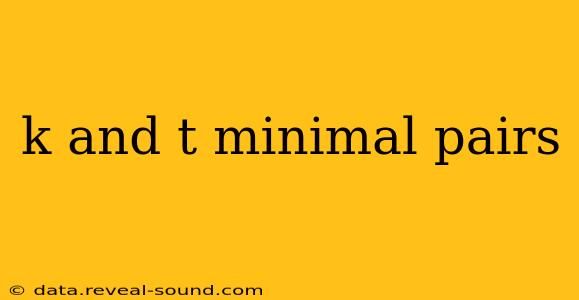Minimal pairs are a cornerstone of phonetics and phonology, helping learners distinguish between sounds that might be easily confused. This post focuses on the minimal pair /k/ and /t/, two voiceless plosives in English that, while seemingly similar, can significantly impact word meaning and comprehension. Mastering the subtle differences between these sounds is crucial for clear and accurate pronunciation, particularly for non-native English speakers.
What are Minimal Pairs?
Before diving into the specifics of /k/ and /t/, let's define minimal pairs. They are pairs of words that differ in only one phoneme—one sound—in the same position, resulting in a change of meaning. For example, "bat" and "cat" are a minimal pair; they differ only by the initial consonant sound. Understanding minimal pairs allows learners to focus on the precise articulation of individual sounds and their impact on word meaning.
Distinguishing /k/ and /t/: Key Differences in Articulation
The sounds /k/ and /t/ are both voiceless plosives, meaning they are produced by stopping the airflow briefly in the vocal tract before releasing it. However, the place of articulation is what sets them apart:
-
** /k/ (voiceless velar plosive):** The airflow is stopped at the velum (soft palate) at the back of the mouth. Try producing the sound—you'll feel the back of your tongue touching the soft palate.
-
** /t/ (voiceless alveolar plosive):** The airflow is stopped at the alveolar ridge—the bumpy ridge just behind your upper teeth. Feel the tip of your tongue touching this ridge when you pronounce /t/.
This seemingly small difference in placement leads to a noticeable change in sound, and consequently, meaning.
Examples of Minimal Pairs with /k/ and /t/
Here are some examples of minimal pairs in English that highlight the difference between /k/ and /t/:
| Word with /k/ | Word with /t/ |
|---|---|
| cat | tat |
| coat | tote |
| cake | take |
| cool | tool |
| kite | tight |
| kick | tick |
These examples demonstrate how a simple change in the initial consonant profoundly affects word meaning. Focusing on the precise placement of the tongue—velum for /k/ and alveolar ridge for /t/—is key to accurate pronunciation.
Common Errors and How to Avoid Them
Non-native speakers often struggle to distinguish between /k/ and /t/, leading to mispronunciations that can affect comprehension. Common errors include:
-
Producing a /k/ sound where a /t/ is needed (and vice versa): This usually stems from a lack of awareness of the precise articulation points.
-
Aspirating /k/ inconsistently: English /k/ often has a slight puff of air after the release, but this aspiration isn't always consistent. Paying attention to this detail can enhance clarity.
Tips for Improvement:
-
Mirror practice: Observe your mouth movements in a mirror while practicing the sounds repeatedly.
-
Minimal pair drills: Practice saying minimal pairs aloud, focusing on the subtle differences in articulation.
-
Record yourself: Listening back to recordings can help you identify areas for improvement in your pronunciation.
-
Listen to native speakers: Immerse yourself in English by listening to native speakers pronounce these sounds in different contexts.
How Do I Improve My Pronunciation of /k/ and /t/?
This question often arises for learners. Consistent practice is key. Focus on the subtle differences in tongue placement, practice minimal pairs regularly, and utilize the tips mentioned above. Consider seeking feedback from a language tutor or using pronunciation apps for personalized guidance.
What are Some More Examples of /k/ and /t/ Minimal Pairs?
Many more minimal pairs exist beyond those listed. The key is to find words that differ only in this single phoneme. Think of word families and experiment with substituting /k/ and /t/ to create your own minimal pair exercises.
By focusing on the articulation differences, consistent practice, and utilizing various learning strategies, you can master the distinction between /k/ and /t/, significantly improving your English pronunciation and fluency. Remember, clear pronunciation is essential for effective communication.
